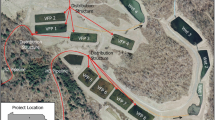Abstract
Passive (wetland) treatment of waters drainingabandoned and derelict mine sites has a numberof detractions. Detailed knowledge of many ofthe fundamental processes that dictate theperformance and longevity of constructedsystems is currently very limited and thereforemore research effort is needed before passivetreatment becomes an “off-the-shelf” technology.
Similar content being viewed by others
References
Banks D, Younger PL, Arnesen R–T, Iversen ER & Banks SB (1997) Mine–water chemistry: the good, the bad and the ugly. Environ. Geol. 32: 157–174
Barton CD & Karathanasis AD (1999) Renovation of a failed constructed wetland treating acid mine drainage. Environ. Geol. 39: 39–50
Beining BA & Otte ML (1996) Retention of metals originating from an abandoned lead–zinc mine by a wetland at Glendalough, Co Wicklow. Biol. Environ.–Proc. R. Irish Acad. 96B: 117–126
Bender J, Gould JP, Vatcharapijarn Y, Young JS & Phillips P (1994) Removal of zinc and manganese from contaminated water with cyanobacteria mats. Water Environ. Res. 66: 679–683
Dennison F, Sen AM, Hallberg KB & Johnson DB (2001) Biological versus abiotic oxidation of iron in acid mine drainage waters:an important role for moderately acidophilic, iron–oxidising bacteria. In: Ciminelli VST & Garcia O Jr. (Ed) Biohydrometallurgy: Fundamentals, Technology and Sustainable Development, vol. 11B (pp 493–501). Elsevier, Amsterdam
Fortin D, Goulet R & Roy M (2000) Seasonal cycling of Fe and S in a constructed wetland: the role of sulfate–reducing bacteria. Geomicrobiol. J. 17: 221–235
Gazea B, Adam K & Kontopoulos A (1996) A review of passive systems for the treatment of acid mine drainage. Miner. Eng. 9: 23–42
Goulet RR & Pick FR (2001) The effects of cattails (Typha latifolia) on concentrations and partitioning of metals in surficial sediments of surface–flow constructed wetlands. Water Air and Soil Pollution 132: 275–291
Hallberg KB & Johnson DB (2001) Biodiversity of acidophilic microorganisms. Adv. Appl. Microbiol. 49: 37–84
Hallberg KB &Johnson DB (2002) Novel acidophiles isolated from moderately acidic mine drainage waters. Hydrometallurgy, in press
Heal KV & Salt CA (1999) Treatment of acidic metal–rich drainage from reclaimed ironstone mine spoil. Water Sci. Technol. 39: 141–148
Kalin M (2001) Biogeochemical and ecological considerations in designing wetland treatment systems in post–mining landscapes. Waste Man. 21: 191–196
Lamb HM, Dodds–Smith M & Gusek J (1998) Development of a long–term strategy for the treatment of acid mine drainage at Wheal Jane. In: Geller A, Klapper H & Salomons W (Ed), Acidic Mining Lakes: Acid Mine Drainage, Limnology and Reclamation (pp 335–346). Springer, Berlin
Lovley DR (1991) Dissimilatory Fe(III) and Mn(IV) Reduction. Microbiol. Rev. 55: 259–287
Manyin T, Williams FM & Stark LR (1997) Effects of iron concentration and flow rate on treatment of coal mine drainage in wetland mesocosms: An experimental approach to sizing of constructed wetlands. Ecol. Eng. 9: 171–185
Mays PA & Edwards GS (2001) Comparison of heavy metal accumulation in a natural wetland and constructed wetlands receiving acid mine drainage. Ecol. Eng. 16: 487–500
McGinness S, Brown MME, Atkinson K & Webb JS (1996) Constructed wetlands: a flawed concept? In: Riddler G (Ed) Minerals, Metals and the Environment II, The Institution of Mining and Metallurgy (pp 325–336). London
Mitsch WJ & Wise KM (1998) Water quality, fate of metals, and predictive model validation of a constructed wetland treating acid mine drainage. Water Res. 32: 1888–1900
Nordstrom DK (2000) Advances in the hydrogeochemistry and microbiology of acid mine waters. Int. Geol. Rev. 42: 499–515
O'Sullivan AD, McCabe OM, Murray DA & Otte ML (1999) Wetlands for rehabilitation of metal mine wastes. Biol. Environ.–Proc. R. Irish Acad. 99B: 11–17
Peiffer S, Walton–Day K & Macalady DL (1999) The interaction of natural organic matter with iron in a wetland (Tennessee Park, Colorado) receiving acid mine drainage. Aquat. Geochem. 5: 207–223
Phillips P, Bender J, Simms R, Rodriguezeaton S & Britt C (1995) Manganese removal from acid coal–mine drainage by a pond containing green–algae and microbial mat. Water Sci. Technol. 31: 161–170
Tarutis WJ, Stark LR & Williams FM (1999) Sizing and performance estimation of coal mine drainage wetlands. Ecol. Eng. 12: 353–372
Thompson DN, Sayer RL & Noah KS (2000) Sawdust–supported passive bioremediation of western United States acid rock drainage in engineered wetland systems. Miner. Metall. Process. 17: 96–104
Tyrrell WR, Mulligan DR, Sly LI & Bell LC (1997) Trialing wetlands to treat coal mining wastewaters in a low rainfall, high evaporation environment. Water Sci. Technol. 35: 293–299
Vile MA & Wieder RK (1993) Alkalinity generation by Fe(III) reduction versus sulfate reduction in wetlands constructed for acid mine drainage treatment. Water, Air Soil Pollut. 69: 425–441
Wieder RK & Lang GE (1982) Modification of acid mine drainage in a freshwater wetland. In: McDonald BR (Ed), Proceedings of the Symposium on Wetlands of the Unglaciated AppalachianRegion (pp 43–53). West Virginia University, Morgantown, U.S.A.
Wood TS & Shelley ML (1999) A dynamic model of bioavailability of metals in constructed wetland sediments. Ecol. Eng. 12: 231–252
Author information
Authors and Affiliations
Corresponding author
Rights and permissions
About this article
Cite this article
Johnson, D.B., Hallberg, K.B. Pitfalls of passive mine water treatment. Re/Views in Environmental Science and Bio/Technology 1, 335–343 (2002). https://doi.org/10.1023/A:1023219300286
Issue Date:
DOI: https://doi.org/10.1023/A:1023219300286




